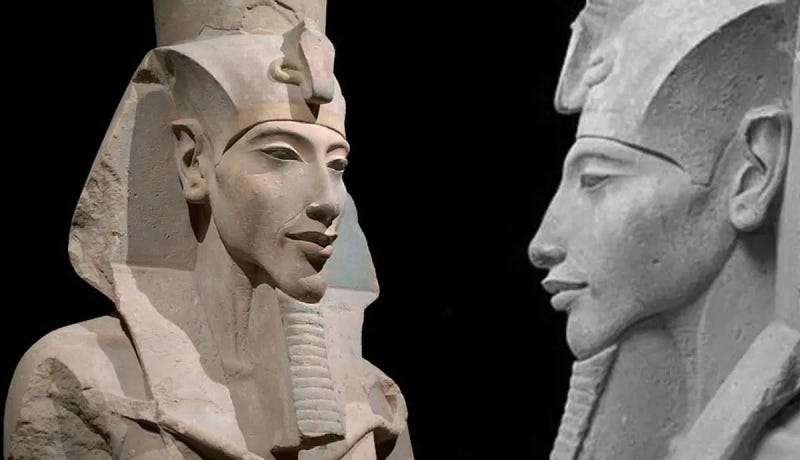King Akhenaten
The Pharaoh Who Changed Everything: King Akhenaten
When people think of ancient Egypt, they often picture grand temples, towering statues of gods, and a long, steady line of pharaohs honoring centuries-old traditions. But not every ruler followed the script. King Akhenaten is one of the most fascinating and controversial figures in all of Egyptian history precisely because he broke the mold — and did so in dramatic fashion.
Before Akhenaten, Egypt worshiped a vast array of gods. Temples to Amun, Osiris, Isis, and dozens of others stood as the spiritual and cultural backbone of Egyptian society. Then came Akhenaten, and with him, a radical shift that shocked the kingdom. Check our daily tours offers!

From Amenhotep IV to Akhenaten
Born as Amenhotep IV, he inherited the throne during the height of the 18th Dynasty, a time of wealth and power. But not long into his reign, he made a decision that would rewrite Egyptian religion. He changed his name to Akhenaten, which means “Effective for Aten,” and began worshiping one god above all others: Aten, the sun disk.
This wasn’t just a matter of personal belief. Akhenaten ordered the closure of temples to other gods, stripped the powerful priesthood of Amun of its influence, and declared Aten the supreme and only deity worthy of state worship. Egypt, a civilization that had been built on centuries of religious plurality, was now being pulled toward a form of monotheism — something almost unheard of in the ancient world. Check our Nile cruises offers!

The City of Akhetaten
To reinforce his vision, Akhenaten built a brand-new capital city called Akhetaten (modern-day Amarna) in a remote stretch of desert along the Nile. He moved the royal court, his family, artists, and officials there, leaving behind the temples and politics of Thebes. The city was a clean break from the past — a place where Aten reigned supreme and Akhenaten could shape his new world.
The city itself was laid out differently from other Egyptian capitals. Temples to Aten were open to the sky rather than enclosed, emphasizing the god’s connection to sunlight. Art in Amarna also changed. Instead of stiff, idealized forms, we see more naturalistic scenes: the royal family shown in intimate moments, Akhenaten with his wife Nefertiti, and their daughters under the rays of Aten. Check our daily travel packages offers!
A Pharaoh Unlike Any Other
Akhenaten’s appearance in art was just as revolutionary as his theology. He was portrayed with elongated limbs, a narrow chest, wide hips, and an almost androgynous face. Some historians have suggested medical explanations, but most now believe this was a symbolic choice — meant to emphasize his divine nature and connection to Aten.
More than anything, Akhenaten wanted to be seen not just as a king but as the chosen representative of his god. He stood between the people and Aten, making him a central figure in worship. For a time, this vision dominated Egypt’s religious and cultural life. Check our Nile cruises offers!
The Fall of a Dream
But Akhenaten’s religious revolution was short-lived. After his death, likely around 1336 BCE, the new capital was abandoned. The next pharaohs, including his probable son Tutankhamun, restored the old gods and moved the court back to Thebes. Akhenaten’s monuments were defaced or dismantled, his name erased from king lists, and his memory all but wiped from official history.
It wasn’t until centuries later, when archaeologists uncovered the ruins of Amarna and studied his surviving inscriptions, that Akhenaten’s story began to reemerge. What they found was not just the record of a ruler, but of a bold and deeply personal vision — one that challenged the very foundation of Egyptian civilization.
Why Akhenaten Still Matters
Akhenaten’s reign is one of the most remarkable chapters in ancient history. His attempt to reshape religion, art, and kingship was radical, risky, and ultimately unsustainable. But his story endures because it reminds us that even in the most stable and tradition-bound societies, change is possible — sometimes by the will of a single person.
He wasn’t a conqueror or a builder of pyramids, but his ideas challenged thousands of years of belief. Whether you see him as a religious visionary, a political disruptor, or a ruler who overreached, Akhenaten remains one of history’s most compelling figures.
His legacy may have been buried, but it was never completely lost. Reserve now with Egypt trips package and check our travel packages, day tours and nile cruises special offers!
.jpg)


Comments
Post a Comment